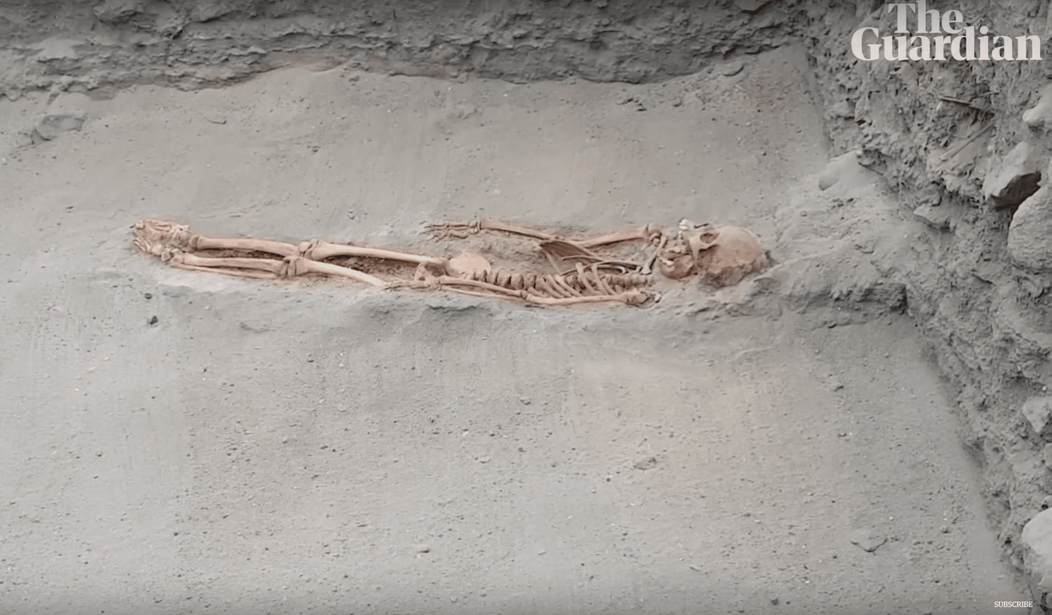Every Columbus Day, liberals insist that the story of European colonization is a simple narrative of good versus evil: horrible Europeans came upon innocent Native Americans, introducing slavery, exploitation, and oppression. A massive archaeological discovery blows one of many gaping holes in this narrative. While Europeans did indeed do horrible things, the natives weren’t exactly innocent.
Two hundred and fifty skeletons of children between the ages of 4 and 14 have been unearthed at Huanchaco, Peru, in what experts say is likely the world’s largest child-sacrifice site. Huanchaco is a site of the Chimú culture (1200-1400), a predecessor to the mighty Inca Empire, which also carried out child sacrifices.
“This is the biggest site where the remains of sacrificed children have been found,” the excavation’s chief archaeologist, Feren Castillo, told AFP in August. “There isn’t another like it anywhere else in the world.”
The Peruvian press agency Andina reported that archaeologists discovered the skeletal remains of 250 children and 40 warriors at the site, which is 346 miles north of Peru’s capital of Lima.
The children were reportedly sacrificed to honor the Chimú gods. Experts say the children were sacrificed in relation to an “El Niño” event. They were killed during wet weather and buried facing the sea.
This is horrible news for the Native American innocence myth. The very worst site for a particularly horrific form of human sacrifice — the ritual killing of children! — long predates Christopher Columbus’s first steps in the New World.
Horrifying as this discovery is, it should not surprise anyone. Human sacrifice is tragically common throughout history, just like slavery. People in the Ancient Near East, Europe, China, Tibet, India, the Pacific, and West Africa practiced it — and it was horrifically common in the pre-Columbian Americas.
In Meso-America, the Mixtec sacrificed rulers who lost a ballgame, while the Maya sacrificed humans to close sinkholes — with many of those sacrificed being under 20 years old. The Aztecs infamously sacrificed roughly 80,400 prisoners (mostly defeated warriors) by ripping out their hearts. They also sacrificed children to appease their rain god, who required children’s tears.
In fact, the Day of the Dead festivities (before, during, and after Halloween) popular in modern Mexico extend back to Chapultepec Park, the resort of Montezuma and other Aztec rulers. The modern display of skulls is reminiscent of Aztec skull racks, huge wooden frames holding the impaled heads of enemies or sacrificial victims, the Chicago Tribune reported.
Many native tribes in the area that would become the United States also practiced human sacrifice. The Pawnee practiced an annual Morning Star Ceremony, which included the sacrifice of a young girl — until the 1800s.
The South American natives also sacrificed humans. The Moche of Eastern Peru sacrificed teenagers en masse. The Inca would sacrifice royal retainers when a leader died. For instance, as many as 4,000 servants, court officials, favorites, and concubines were killed upon the death of Emperor Huayna Capac in 1527. Mummies of sacrificed children have been recovered in the Inca regions of South America. The Inca also performed child sacrifices during important events, such as the death of an emperor or during a famine.
None of this is to suggest the Native Americans were uniquely evil — human sacrifice is tragically common in ancient cultures. Its eradication is one more reason why the Western heritage should be celebrated, not demonized.
Western morality rightly condemns human sacrifice. According to the Bible, the Jewish God prohibited the practice in the Ancient Near East, but both the Kingdom of Israel and the Kingdom of Judah often lapsed back into the barbaric practice. The Romans had practiced human sacrifice but very infrequently — and explicitly banned the practice before the emergence of Christianity.
Christianity not only banned human sacrifice, but also the barbaric practices of pharmacological abortion and infant exposure — leaving unwanted babies to die in the woods. Christianity would also ban slavery in the early medieval era, and later inspire the abolitionist movement in the 1800s.
The Judeo-Christian Western heritage is far from perfect, but the ideals at its center have inspired the unprecedented prosperity of capitalism, the freedom of limited government, and the abolition of slavery and human sacrifice. The left’s attempts to demonize this heritage are disgusting — and they threaten to undermine the values that have so benefitted Americans and people across the world.
A Swedish professor has tried to normalize eating human flesh in an effort to fight climate change. How is this different from the idea of human sacrifice to appease the gods of wind and rain?
The archaeological discovery in Peru should serve as a reminder that the modern prosperity, freedom, and morality we now enjoy is not the norm in human history. These benefits must be defended, and those of us who enjoy them should be grateful to the Western heritage from which they sprang.
Follow Tyler O’Neil, the author of this article, on Twitter at @Tyler2ONeil.









Join the conversation as a VIP Member